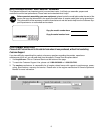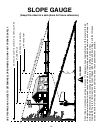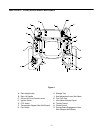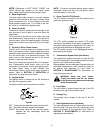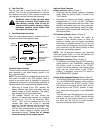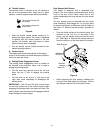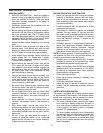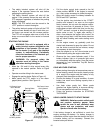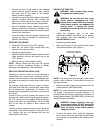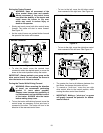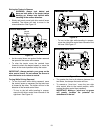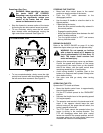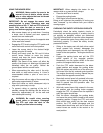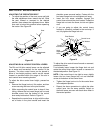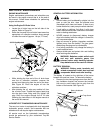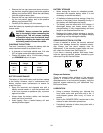
17
• Connect the end of one cable to the disabled
tractor battery’s positive terminal; then connect
the other end of that cable to the booster
battery’s positive terminal.
• Connect one end of the other cable to the booster
battery’s negative terminal; then connect the
other end of that cable to the frame of the dis-
abled tractor, as far from the battery as possible.
• Start the disabled tractor following the normal
starting instructions previously provided; then
disconnect the jumper cables in the exact reverse
order of their connection.
• Have the tractor’s electrical system checked and
repaired as soon as possible to eliminate the
need for jump starting.
STOPPING THE ENGINE
• Place the PTO switch in the “OFF” position.
• Move the RH and LH drive control levers fully
outward in the neutral position.
• Engage the parking brake.
• Move the throttle control between the half and full
trottle positions, and turn the ignition key to the
“OFF” position.
• Remove the key from the ignition switch.
NOTE:
Always remove the key from the ignition
switch to prevent accidental starting or battery
discharge if the equipment is left unattended.
PRACTICE OPERATION (INITIAL USE)
Operating a zero-turn tractor is not like operating a
conventional type riding tractor. Although and be-
cause a zero-turn tractor is more maneuverable, get-
ting used to operating the control levers takes some
practice.
We strongly recommend that you locate a reason-
ably large, level and open "practice area" where there
are no obstructions, pedestrians, or animals. You
should practice operating the tractor for a minimum of
30 minutes.
Carefully move (or have moved) the tractor to the
practice area. When performing the practice session,
the PTO should not be engaged. While practicing,
operate the tractor at approximately 1/2-3/4 throttle
and at less than full speed in both forward and
reverse.
Carefully practice maneuvering the tractor using the
instructions in the following section "Driving the Trac-
tor." Practice until you are confident that you can
safely operate the tractor.
DRIVING THE TRACTOR
WARNING: Avoid sudden starts, exces-
sive speed and sudden stops.
WARNING: Do not leave the seat of the
tractor without disengaging the PTO,
moving drive control levers fully outward
in the neutral position, and engaging the
parking brake. If leaving the tractor
unattended, turn the ignition key off and
remove key.
• Adjust the operator’s seat to the most
comfortable position that allows you to operate
the controls. See seat adjustment in the
ADJUSTMENTS section.
• Release the parking brake.
• Move the RH and LH drive control levers inward
in the neutral position. See Figure 11.
Figure 11
NOTE: If the control levers are not even in the neutral
position, refer to Section 3 and adjust the levers so
that they are even.
• Move the throttle control lever forward to the full
throttle position (3500-3600 RPM).
NOTE: The tractor and engine are designed to run at
full throttle. If performing a practice session, it is
preferable that the tractor is operated at less than full
throttle (approximately 2500-3000 RPM), but this only
applies to practice operation.
WARNING: Always maintain a firm grip
on the control levers. DO NOT release the
control levers to slow or stop the tractor;
move the levers to the neutral position
using your hands.
• To drive the tractor, firmly grasp the respective
drive control levers with your right and left hands
and proceed as described in the following sub-
sections.
Control Lever Moved
Inward and in Neutral



